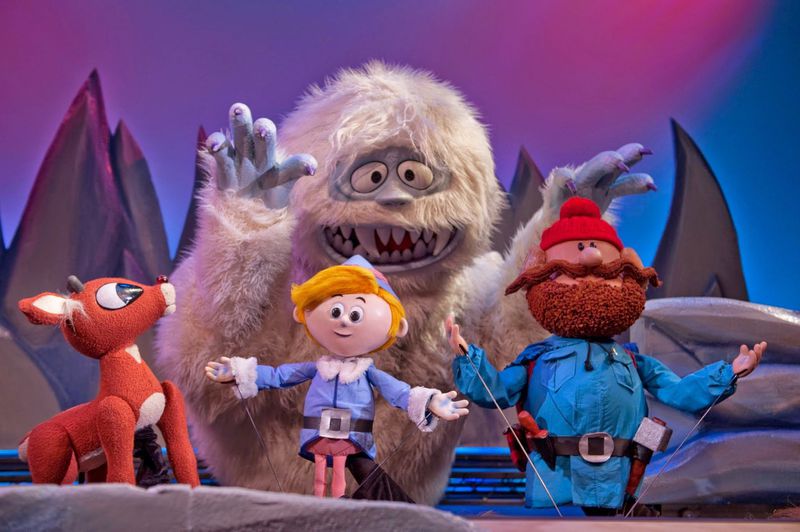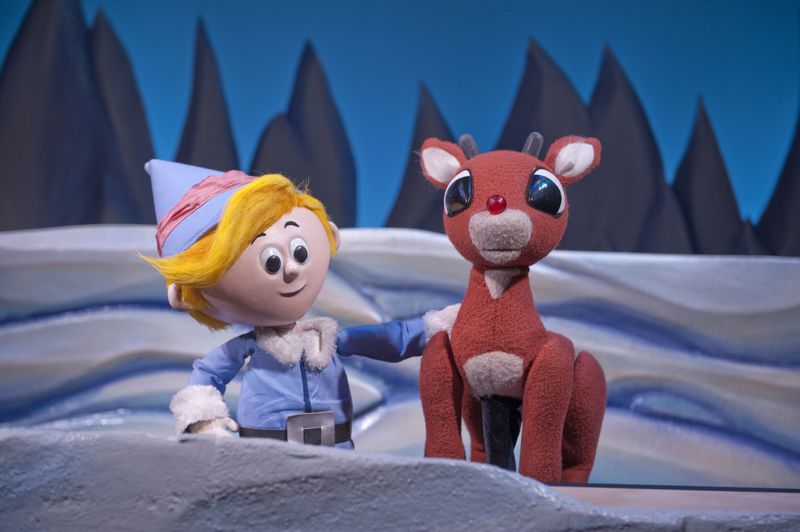All across snowy Atlanta (OK, not snowy, but one can wish), theater companies are staging “A Christmas Carol” or decking their halls with other holiday confections. But, say you’re a theatergoer who wants to go walking in a Winter Wonderland, or the closest you can come to it in a city where every sled is gridlocked on a 70-degree fall day. It’s hard to top the Center for Puppetry Arts.
Now through Jan. 2, the Midtown funhouse has been transformed into “Christmas Town,” with giant snowflakes dangling from its atrium’s high ceiling, multiple Christmas trees sparkling with lights, and gift-wrapped presents stacked high.
At one end of the lobby, there’s even a circa-1950s coin-operated Rudolph the Red-Nosed Reindeer amusement ride of the sort that sat outside sundry stores before insurance liability became such a buzz kill. Upstairs, kids and parents collaborate on Rudolph shadow puppets in the Create-A-Puppet Workshop.
It’s like the holiday set has escaped the theater and is gradually wrapping everything that isn’t moving in sparkly reds, greens and silvers.
All of this and more plays a supporting role for the puppetry center’s main attraction, “Rudolph the Red-Nosed Reindeer,” the puppet show based on the 1964 stop-motion animated Christmas television special.
“Rudolph” is to the Center for Puppetry Arts what “The Nutcracker” is for Atlanta Ballet and a thousand other dance companies: a provider of holiday jingle that bolsters the bottom line year-round. After taking last Christmas off due to the pandemic, “Rudolph” has returned to the puppetry center to light up the holidays for the 11th year with his bulbous red nose.
Upping the nostalgia ante, the Center for Puppetry Arts also is presenting an exhibit of the Rudolph and Santa puppets from the 1964 Rankin/Bass Productions TV special, made in collaboration with animation wizard Tadahito Mochinaga and his MOM Film Studio in Tokyo. The wee figures are given big-star treatment, displayed inside an acrylic vitrine in a gallery a level below the theater. Guests reach the display at the end of a hall of blue-white shimmering material that makes you feel like you’re strolling amid North Pole icebergs toward Something Very Important.
The 6-inch-tall Rudolph and 11-inch-tall Santa, handmade creations of Japanese puppet-maker Ichiro Komuro, command the entire gallery, set off by a backdrop painted with snowy trees. It’s the kind of star treatment one would expect for King Tut’s tomb, reflecting how beloved the puppets are — and perhaps also how valuable.
In a sale held in Los Angeles by Profiles in History auction house late last year, the figures went for $368,000, far eclipsing their estimated value of $150,000 to $200,000. That’s quite an uptick from when an “Antiques Roadshow” expert appraised them for $8,000 to $10,000 in 2005, after a family member of Barbara Adams, an employee of Rankin/Bass in the 1970s, retrieved them from the attic. That was before a detailed restoration that returned Rudolph’s red nose and half of Santa’s yak-hair mustache.
Now they are on long-term loan to the Atlanta institution.
The puppet styles employed in the center’s production of Rudolph are different from the TV classic, and include rod, body and blacklight puppets, often enhanced by projected moving images.
Jon Ludwig’s adaptation is faithful to the original storyline, encouraging the self-acceptance of those who are different — or, as the script refers to them, “misfits.”
The CliffsNotes version: Rudolph is born at the North Pole, with a nose that lights up traffic-light red. Santa, community members, even Rudolph’s dad, reject the fawn, who strikes out on his own. Eventually he meets and befriends Hermey, a runaway elf who would prefer a career in dentistry to one as a toy-maker in Santa’s Workshop, and Yukon Cornelius, a prospector on a fruitless search for silver and gold.
After escaping the Abominable Snowmonster (who, with his mischievous, Muppet-like manner, himself seems to have escaped the center’s Jim Henson exhibition across the atrium), they land on the Island of Misfit Toys. It’s a sad stash of unloved or unwanted playthings — which no doubt inspired Pixar’s mega-million “Toy Story” franchise.
Credit: Center for Puppetry Arts
Credit: Center for Puppetry Arts
Soon realizing that his illuminated nose is endangering his growing group of misfit friends, and, as the program notes, “that he can’t run from who he is,” Rudolph returns home. Much to his surprise, he is welcomed warmly, appreciated finally for his bravery and uniqueness. All the other misfits soon reach a happy ending, as well.
Ludwig’s version hews close to the original for contractual reasons, but also by choice, he said.
“It was very important to us and the rights holders that we stay true to the original,” the center’s artistic director said. “This was the fun and the artistic challenge. It is a wonderful script and the design is iconic. The film was classic stop-motion puppetry, so we were confident a live puppetry version would work well. We did our best to re-create the look and voices.”
There were some “practical adaptations” required in switching from film to live theater involving six puppeteers, Ludwig said. For instance, the film was able to seamlessly cut back and forth between two scenes, such as “Reindeer Games” and “We Are Santa’s Elves.” “For the live theater it made more sense to stay in the scene until it was finished.”
Though they improvised here and there, Ludwig said he and his collaborators, including current director Tim Sweeney, sought to capture the essence of “Rudolph.”
“‘Rudolph’ has endured for so long because it has a great message about being different and being accepted,” said Ludwig, who as a young buck viewed the premiere broadcast in 1964. “It is OK to be different. Being different might even save the day.”
Credit: ArtsATL
Credit: ArtsATL
Working closely with the American Press Institute, The Atlanta Journal-Constitution is embarking on an experiment to identify, nurture and expand a network of news partnerships across metro Atlanta and the state.
Our newest partner, ArtsATL (www.artsatl.org), is a nonprofit organization that plays a critical role in educating and informing audiences about metro Atlanta’s arts and culture. Founded in 2009, ArtsATL’s goal is to help build a sustainable arts community contributing to the economic and cultural health of the city.
Over the next several weeks, we’ll be introducing more partners, and we’d love to hear your feedback.
You can reach Managing Editor Mark A. Waligore via email at mark.waligore@ajc.com.
About the Author






